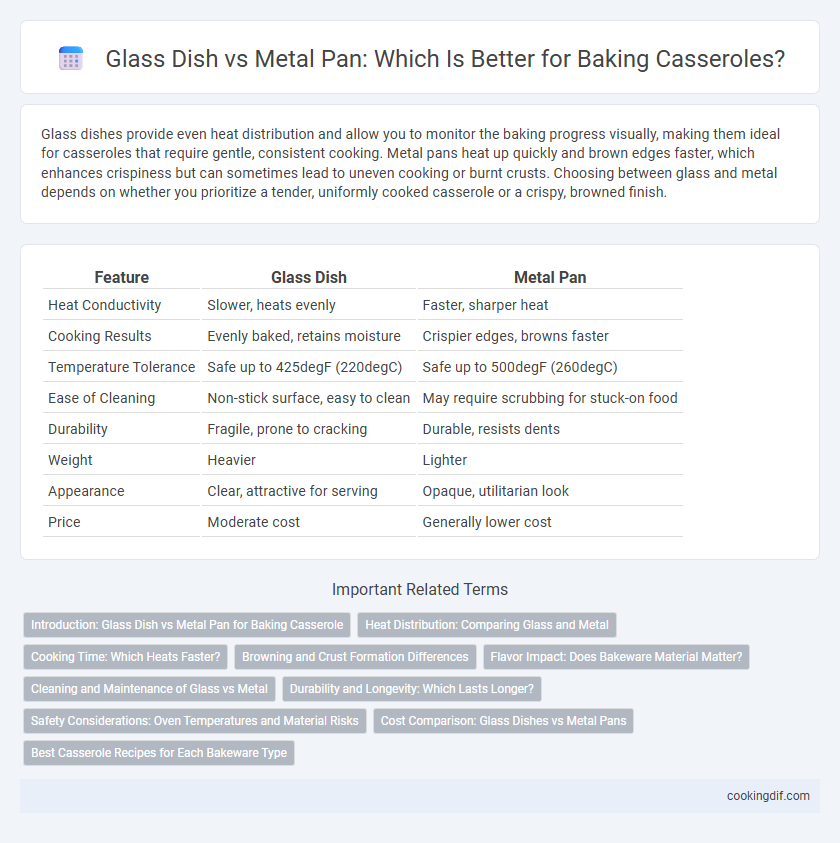Glass dishes provide even heat distribution and allow you to monitor the baking progress visually, making them ideal for casseroles that require gentle, consistent cooking. Metal pans heat up quickly and brown edges faster, which enhances crispiness but can sometimes lead to uneven cooking or burnt crusts. Choosing between glass and metal depends on whether you prioritize a tender, uniformly cooked casserole or a crispy, browned finish.
Table of Comparison
| Feature | Glass Dish | Metal Pan |
|---|---|---|
| Heat Conductivity | Slower, heats evenly | Faster, sharper heat |
| Cooking Results | Evenly baked, retains moisture | Crispier edges, browns faster |
| Temperature Tolerance | Safe up to 425degF (220degC) | Safe up to 500degF (260degC) |
| Ease of Cleaning | Non-stick surface, easy to clean | May require scrubbing for stuck-on food |
| Durability | Fragile, prone to cracking | Durable, resists dents |
| Weight | Heavier | Lighter |
| Appearance | Clear, attractive for serving | Opaque, utilitarian look |
| Price | Moderate cost | Generally lower cost |
Introduction: Glass Dish vs Metal Pan for Baking Casserole
Glass dishes provide even heat distribution and allow visual monitoring of the casserole's cooking progress, making them ideal for recipes requiring gradual, consistent baking. Metal pans, typically made from aluminum or stainless steel, heat up quickly and produce crispy edges due to their superior heat conduction, which enhances texture contrasts in casseroles. Choosing between glass and metal depends on desired cooking results and the casserole's specific heating requirements.
Heat Distribution: Comparing Glass and Metal
Glass dishes provide even heat distribution, ensuring casseroles cook uniformly without hot spots. Metal pans conduct heat faster and offer better browning due to their high thermal conductivity. Choosing between glass and metal depends on whether consistent cooking or crisp edges are the priority for the casserole.
Cooking Time: Which Heats Faster?
Metal pans heat up faster than glass dishes due to their superior thermal conductivity, reducing overall cooking time for casseroles. Glass dishes retain heat longer, promoting even cooking but requiring a slightly longer heating period to reach the desired temperature. Choosing metal pans can accelerate browning and crisping, while glass ensures consistent heat distribution for thicker, layered casseroles.
Browning and Crust Formation Differences
Glass dishes retain heat evenly, promoting consistent browning and allowing casseroles to develop a thicker, slower-forming crust. Metal pans conduct heat more efficiently, resulting in faster, more intense browning and a crisper, thinner crust on the casserole surface. Choosing between glass and metal depends on desired crust texture and browning intensity for optimal casserole results.
Flavor Impact: Does Bakeware Material Matter?
Glass dishes promote even heat distribution and retain moisture, resulting in a tender, flavorful casserole with crisp edges. Metal pans conduct heat faster, enhancing browning and caramelization, which intensifies savory and roasted flavors. Choosing bakeware material directly influences texture and flavor profiles, making metal ideal for crispiness and glass perfect for moist, evenly cooked casseroles.
Cleaning and Maintenance of Glass vs Metal
Glass dishes for casserole baking offer smooth, non-porous surfaces that resist staining and are dishwasher safe, making cleaning straightforward and efficient. Metal pans, especially those with non-stick coatings, require gentle hand washing to prevent scratching and rust, increasing maintenance efforts. Over time, glass maintains clarity without discoloration, whereas metal can degrade with frequent use and harsh scrubbing.
Durability and Longevity: Which Lasts Longer?
Glass dishes offer excellent resistance to staining and do not react with acidic ingredients, maintaining their clarity and performance over time, but they are prone to chipping or cracking if subjected to sudden temperature changes. Metal pans, especially those made from stainless steel or heavy-gauge aluminum, provide superior durability against impact and frequent use, often lasting many years without warping. Despite their robustness, metal pans may discolor or develop surface wear, while glass maintains a consistent appearance but requires more careful handling to ensure longevity.
Safety Considerations: Oven Temperatures and Material Risks
Glass dishes, typically made from tempered borosilicate or soda-lime glass, withstand oven temperatures up to 450degF (232degC) but can shatter under sudden temperature changes, posing safety risks. Metal pans, such as aluminum or stainless steel, tolerate higher temperatures and provide even heat distribution, reducing the risk of hot spots and burnt edges, but metals can leach trace amounts of aluminum or react with acidic ingredients. Choosing between glass and metal for casseroles involves balancing the thermal stability and chemical safety, considering oven temperature limits and the type of food prepared.
Cost Comparison: Glass Dishes vs Metal Pans
Glass dishes for baking casseroles generally have a higher upfront cost compared to metal pans, with prices ranging from $15 to $40 depending on size and brand. Metal pans, often made of aluminum or stainless steel, are typically more affordable, costing between $10 and $25, making them a budget-friendly option for everyday cooking. The durability of metal pans can offer longer-lasting value, while glass dishes may require more careful handling to avoid breakage, influencing overall cost-effectiveness over time.
Best Casserole Recipes for Each Bakeware Type
Glass dishes provide even heat distribution and are ideal for recipes requiring slow, consistent cooking such as creamy casseroles and layered vegetable bakes. Metal pans excel in delivering a crispier crust and are best suited for hearty dishes like cheesy potato casseroles or meat-based bakes where browning is desired. Choosing the right bakeware enhances texture and flavor, optimizing the results of your casserole recipes based on heat conduction and cooking style.
Glass dish vs Metal pan for baking casserole Infographic

 cookingdif.com
cookingdif.com